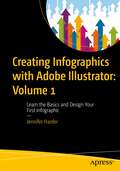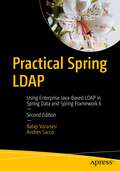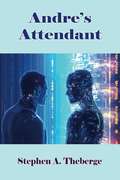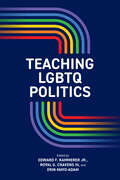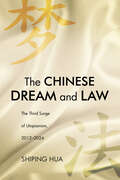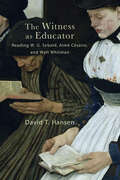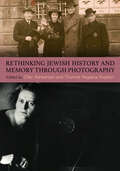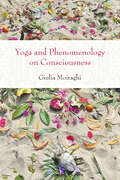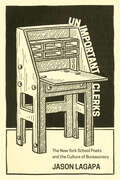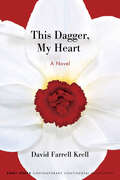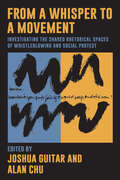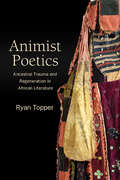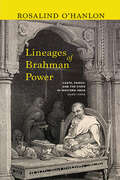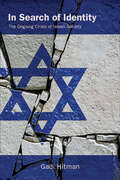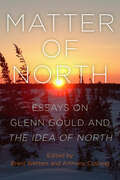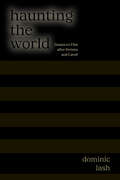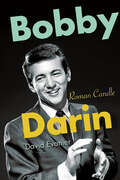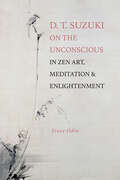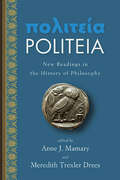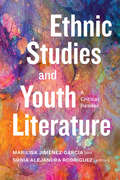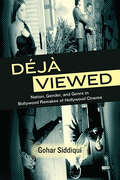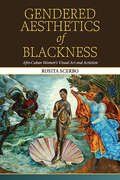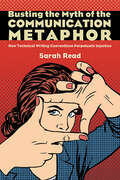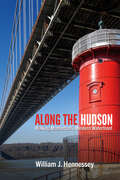- Table View
- List View
Creating Infographics with Adobe Illustrator: Learn the Basics and Design Your First Infographic
by Jennifer HarderThis full-color book will teach you how to use Adobe Illustrator's various tools to create infographics, as well as basic page layouts for them. This is the first of three volumes which will cover all the fundamentals of Illustrator, an industry standard application used by graphic designers and marketing and communication teams. How is an infographic different from a logo or any other illustration? What additional thought processes, skills, or software tools should be utilized to create an infographic? In this first volume of Illustrator Basics, you will learn the answers to all these questions. Author Jennifer Harder will walk you through creating basic infographics in Illustrator using Basic Shape tools, Pen Tools, Type Tools, and Symbols. Upon completing this volume, you will have an appreciation for how easy it is to design an infographic and discover how rudimentary shapes and colors can affect readability while conveying meaning to your audience. You will be able to use this knowledge to create your own infographics using Illustrator’s wide array of tools. Who This Book Is For Discover the tools within Illustrator that are ideal for creating basic infographicsDevelop a logo based upon a scanned sketchGain an understanding of different infographic layouts and the process of reviewing them with your client Who This Book Is For Beginner-level designers and others who are interested in learning the process of creating infographics for their company, the classroom, for a visual resume, an article in a magazine, or a webpage.
Practical Spring LDAP: Using Enterprise Java-Based LDAP in Spring Data and Spring Framework 6
by Balaji Varanasi Andres SaccoThis revised edition is your practical, hands-on guide to developing Java-based enterprise applications with big data or batches of data using the Spring LDAP and the Spring Data LDAP frameworks. The book covers these popular Spring project modules and explains the purpose and fundamental concepts of LDAP before giving a comprehensive tour of the latest version of Spring LDAP and Spring Data LDAP as found in Spring Framework 6. The book provides a detailed treatment of LDAP controls and the new features of Spring LDAP such as Object Directory Mapping and LDIF parsing. LDAP has become the de facto standard for storing and accessing information in enterprises. Despite its widespread adoption, developers often struggle when it comes to using this technology effectively. The traditional Java LDAP and JNDI approaches have proven to be painful and have resulted in complex, less modular applications. The Spring LDAP framework provides an ideal alternative.After reading and using this book, you'll come away with a level of comfort for working with large batches of data or big data in your enterprise Spring applications development.What You'll LearnExplore "What is Java LDAP?" and understand the Spring LDAP and Spring Data LDAP frameworksSearch LDAP resourcesSort and page your LDAP resultsDive into object directory mappingHandle LDAP transactions and moreWho This Book Is ForIntermediate to advanced Java and Spring software developers; programmers with at least some prior experience in Java, especially the Spring Framework
Grateful for Animals: Spiritual Comfort and Wisdom in Life's Last Chapter
by Gail Pope Carol Howe HulseHow might the spiritual comfort and wisdom shared by animals inspire you to live and connect more deeply with yourself and others from your heart and soul—where love remains the prevailing principle? GRATEFUL for Animals: Spiritual Comfort & Wisdom in Life’s Last Chapter honors the human-animal bond as the authors gently explore the many ways animals are indeed wise and wonderful guides and companions on the spiritual journey. This heartwarming book also shares uplifting lessons learned from animals during their last chapter of life, which are extremely relevant at every life stage. You, too, can live well and fully through the last breath!
Andre's Attendant
by Stephen A. ThebergeThe story begins in the 2030s. The Great Purge, a plague infinitely worse than Covid, wipes out a large part of the world’s population. After his long convalescence, Andre, a wealthy writer, is now a paraplegic as well as blind. He engages Jared, a solicitous personal care attendant, and manages to remain more or less independent in his boyhood home on the East Coast. <P><P> Andre also invests in android development. After all, androids are very much needed to fill many jobs after the deaths of so many humans. But neither Andre’s motives nor those of a great many others are entirely altruistic. <P><P> The story moves quickly into the worlds of mob bosses, drug deals, prostitution, and even art forgery, but also into the emotional realm of growing attachment between Andre and Jared. <P><P> What people thought were their servants soon get more ambitious ideas, and they move into the world of politics. They twist religious texts into cloaks of respectability and justification for their actions. The results of their power grab, of course, are disastrous for humankind. Only the epilogue offers a hint of rebellion and a ray of hope. <P><P> Succinct, often moving, and chillingly plausible, this is a tale of near–future possibilities that we can only hope are not just over the horizon here in 2023.
Teaching LGBTQ Politics (SUNY series in Queer Politics and Cultures)
by Erin Mayo-Adam Edward F. Kammerer Jr. Royal G. Cravens IIIAn innovative collection of advice, resources, and ideas for faculty teaching LGBTQ politics.Limited resources exist to support faculty teaching LGBTQ politics. The first of its kind, this edited volume brings together scholars from across the discipline of political science to offer guidance on how to better teach LGBTQ issues. Rooted in and focused on the US context, the book is divided into three sections. The first addresses developing and teaching LGBTQ politics courses, at both the undergraduate and graduate levels. The second offers suggestions for incorporating LGBTQ topics into other political science courses. And the last homes in on various pedagogical concerns that can arise when teaching LGBTQ politics. Contributors provide a host of resources, including lesson plan templates, reading assignments, and strategies and takeaways from their own experiences teaching in the field.
The Chinese Dream and Law: The Third Surge of Utopianism, 2012–2024
by Shiping HuaAnalyzes the major laws promulgated during the Xi Jinping era against a background of the politics and ideology of the Xi regime in general.The Chinese Dream and Law study situates the Chinese Dream in the modern utopianism discourse since the Late Qing, following Kang Youwei and Mao Zedong. As a tool to promote the Chinese Dream, the legal reforms during the period depart from the "thin constitutionalism" of the first three decades of the post-Mao era and resemble aspects of Legalism. Although the current regime has made some progress in protecting people's socioeconomic rights through law, it has retreated on upholding judicial independence to protect people's civil and political rights, especially those vis-à-vis the state. The first three decades since post-Mao reform are an aberration that deviates from the normal trajectory of modern Chinese political development. The decade-long efforts by the current regime have slowed the growing official corruption and have slightly narrowed the growing income gap, although economic growth was cut in half. The Chinese style of utopianism could mean a "better place"—as in the country's ancient past. It could also become a "no place" in the modern diverse world because this human hope that has a universal claim is often built on authoritarian means.
The Witness as Educator: Reading W. G. Sebald, Aimé Césaire, and Walt Whitman
by David T. HansenIlluminates the power in bearing witness as an ethical orientation toward the world and its people.In The Witness as Educator, David T. Hansen examines the idea of bearing witness. He shows how it constitutes an ethical orientation that heeds human yearnings for justice, beauty, and meaning. He engages the work of three exemplary witnesses: W. G. Sebald, Aimé Césaire, and Walt Whitman. Sebald powerfully confronts the human costs of the violence of the nineteenth and twentieth centuries. Césaire evokes a creative Black consciousness in the face of European colonialism and attests to this outlook's joyous and painful development. Whitman's witness to American life, alongside his poignant testimony about caring for wounded soldiers during the American Civil War, speaks to a hope deeper than hope for the prospects of democracy. Hansen shows how these witnesses did not "choose" to write about their respective themes. They had to. The circumstances of their lives and the events of their time summoned them to bear witness. Hansen addresses how their efforts, supplemented by those of other witnesses whose testimony he incorporates, hold considerable educational promise in a world marked by continued misunderstanding and discord and yet also by great possibility.
Rethinking Jewish History and Memory Through Photography (SUNY series in Contemporary Jewish Literature and Culture)
by Ofer Ashkenazi Thomas Pegelow KaplanReveals the significance of photography in modern Jewish history and memory.Rethinking Jewish History and Memory Through Photography highlights the significant role of photography in modern Jewish history and memory. Considering photographs as unique documents that not only depict reality but also shape how it is perceived and remembered, the volume emphasizes the importance of careful photographic analysis in understanding modern Jewish experiences, self-perceptions, and memories. Bringing together leading and emerging scholars, the book offers a range of innovative approaches to central themes in modern Jewish history, including nationalism, migration, race, and antisemitism. In addition to the discussion of various case studies, a variety of methodological approaches for the current and future use of photoanalysis by scholars are presented.
Yoga and Phenomenology on Consciousness (SUNY series, Perspectives in Contemplative Studies)
by Giulia MoiraghiBrings yogic traditions into dialogue with current philosophical and scientific research on consciousness.In this book, philosopher and yoga practitioner Giulia Moiraghi brings yoga into dialogue with current debates on consciousness in analytic philosophy and cognitive science. The book explores embodiment's role in revealing a typically overlooked dimension of consciousness: the horizon consciousness. Bringing major thinkers in phenomenology together with the classical texts of yogic traditions, as well as the author's own firsthand experience, the book argues that yoga, across all the centuries and in its diversity of practices, points toward a common core that should not be left to an archaeological domain of study but should be integrated into ongoing philosophical research on consciousness. By helping the reader understand the relevance of key phenomenological concepts to the practice and actualization of yoga, the book provides a concise and agile tool for general practitioners in the contemplative field and for scholars in consciousness studies, Indian studies, philosophy, psychology, and cognitive science.
Unimportant Clerks: The New York School Poets and the Culture of Bureaucracy
by Jason LagapaExamines the ambivalent, often critical relationship of the New York School poets to bureaucratic culture and the conditions of work.Unimportant Clerks identifies a central tension in the writing of the New York School poets: at times their poetry replicates the ideology of bureaucracy while at others—and more persistently—it repudiates related principles of efficiency, routine, and regimentation. Frank O'Hara, John Ashberry, Barbara Guest, James Schuyler, and Eileen Myles each had a clerical or secretarial job at the start of their professional careers. Heirs to Melville's Bartleby and antecedents of our own era of "quiet quitting," they by necessity channeled their creativity into everyday practices of refusing work. Drawing on a range of anti-work traditions, movements, and theories, Unimportant Clerks shows how their poetry reflects and contests a midcentury administrative ethos, anticipating contemporary critiques of precarity and the demands of office work.
This Dagger, My Heart: A Novel (SUNY series in Contemporary Continental Philosophy)
by David Farrell KrellHistorical fiction centered around the life and tragic death of the German Romantic poet and philosopher Karoline von Günderrode.In 1806, when she was only twenty-six, Karoline von Günderrode plunged a dagger through her heart. She was a gifted poet and philosopher, a member of the circle of Romantic writers such as Bettine Brentano, Clemens Brentano, and Achim von Arnim. Women were not admitted to universities at the time (1780–1806) and so Karoline educated herself with the help of mentors and a library of books. She was devoted to the greatest writers, philosophers, and thinkers of her time and of all times, among them Goethe, Kant, Schelling, Novalis, Hölderlin, Plato, Heraclitus, and Empedocles. Yet neither her learning nor her intense love of nature were able to sustain her life. Karoline fell in love with a Heidelberg professor of classics who was married and unable or unwilling to leave his wife. There were of course other factors that led to her suicide—and the novel details them in its eighty-six episodes narrated by twenty-six different characters. Each character tells her or his or its own version of the story, and the reader is left to piece it all together—which is what one must do when confronting any case of suicide. We are called upon to understand the catastrophe but also to realize that our understanding will never satisfy us. Tragedy is not about understanding. When the old men of Thebes see Antigone marching to her tomb, they can only cry, "Child! Child!"
From a Whisper to a Movement: Investigating the Shared Rhetorical Spaces of Whistleblowing and Social Protest (SUNY series, Studies in Human Rights)
by Joshua Guitar Alan ChuThrough substantive case studies on issues of human rights, this collection of rhetorical investigations engages the interactions among whistleblowers, public protest, and relationships of power.While whistleblowers are commonly viewed as disempowered members of institutions who expose acts of wrongdoing, From a Whisper to a Movement argues that whistleblowing acts can occur from an assemblage of persons and places not typically associated with the term. This theoretical foundation affords us the ability to substantively interrogate the rhetorical linkage between solitary whistleblowing acts, scaffolded around a sense of democratic ethics, and the rhetoric of the consequent publics that demand corrective action. As mass social protests often emerge from singular moments of discovery, the connected discourses expose a unique site within the public forum rich with rhetorical significance. While not all whistleblowing utterances prompt public protests, and only some protests coalesce around the disclosure of wrongdoing, recent history demonstrates that exposed abuses of power often prompt collective action in the name of human rights. This volume interrogates how disempowered actors, often working alone, can inform democratic discourse and global movements.
Animist Poetics: Ancestral Trauma and Regeneration in African Literature (SUNY series, Philosophy and Race)
by Ryan TopperArgues that African literature conceptualizes trauma and regeneration as a more-than-human process, offering an animist revision of psychoanalysis.Psychoanalytic trauma theory largely disregards African perspectives. Postcolonial criticism often filters these perspectives through a secular humanist lens. Examining how African literature uses animism to address the traumas of colonization, Animist Poetics offers a new understanding of the postcolonial condition. From an animist viewpoint, the self is not an individual but rather a regenerative process linking the living, the dead, and their ecosystems. Looking at poetry, fiction, drama, and visual art—including archival manuscripts by Wole Soyinka and Yvonne Vera—Ryan Topper argues that African literature reinvents these Indigenous ecologies in uniquely modern ways. Animist Poetics takes Indigenous—and literary—knowledge seriously, rethinking the foundations of psychoanalysis and charting new theoretical paths in posthumanism, the environmental humanities, new materialism, biopolitics, and memory studies.
Lineages of Brahman Power: Caste, Family, and the State in Western India, 1600–1900 (SUNY series in Hindu Studies)
by Rosalind O'HanlonTraces the role that western India's influential Brahman communities played in shaping India's modern caste system.Western India's Brahman communities have played a key role in the shaping of India's modern caste system. In Lineages of Brahman Power, Rosalind O'Hanlon focuses on their rise to power between the seventeenth and nineteenth centuries, exploring the ways in which some Brahman intellectuals sought to defend the hierarchies of caste against the social changes of the early modern era while others looked for compromise. Drawing on Marathi vernacular sources, O'Hanlon also examines the household, family, and lineage as key sites for Brahman accumulation of skills and cultural capital. This approach also reveals Brahman identity itself as contested, as Brahman subcastes competed with each other not only for service positions and state patronage but also to define who could actually be considered a Brahman, and of what kind. This focus on Brahman social history is novel, in that most historians focus on Brahman power as emerging out of their religious prestige and dominance of intellectual and literary cultures. The emphasis on Brahman identity itself as complex and internally contested also helps to avoid essentializing Brahman power as always and everywhere the same.
In Search of Identity: The Ongoing Crisis of Israeli Society
by Gadi HitmanDescribes and analyzes the main divisions within Israel's heterogenous society.In November 2022, Israeli citizens went to the polls to elect their representatives to the legislature, the Knesset, for the fifth time in less than four years. This was the culmination of a political crisis that began in November 2018 when Avigdor Lieberman resigned from his position as minister of defense after Prime Minister Benjamin Netanyahu refused to approve a significant military move in the Gaza Strip. Since then, Israel has been caught in a political whirlwind. In Search of Identity seeks to find out the nature of the crisis in Israel by analyzing the main rifts in Israeli society. It describes and analyzes the main splits within Israel's heterogenous society, arguing these divisions have social, ideological, and political consequences, the most important being a lack of common national interests and vision. The goal herein is to present a society and country that has long been searching for identity, not only geographically but also in terms of moral values, ethics, and integrity.
Matter of North: Essays on Glenn Gould and The Idea of North
by Brent Wetters Anthony CushingDocuments and illuminates Glenn Gould's groundbreaking radio composition, The Idea of North.Matter of North collects essays and source material related to Glenn Gould's landmark 1967 radio documentary The Idea of North. The most famous product (other than his studio piano recordings) of Gould's 1964 decision to abandon the concert stage for the recording studio, it combines Gould's interests in the contrapuntal (by the simultaneous layering of speaking voices) with philosophy and a life-long fascination with the Canadian Arctic. Because the documentary is a multivalent work, the contributors approach the documentary from unique perspectives (sociological, philosophical, music-theoretical, ethnomusicological), each illuminating a salient aspect of the work. The source-material section includes for the first time the complete interview responses by Gould's five participants, along with other important documentation.
Haunting the World: Essays on Film After Perkins and Cavell (SUNY series, Horizons of Cinema)
by Dominic LashArgues that the experience of the ordinary film viewer and the investigations of the film scholar or film philosopher are not necessarily so far apart.In Haunting the World, Dominic Lash tries to show that taking films seriously in no way interferes with the pleasure we get from watching them. The book draws its title from the philosopher Stanley Cavell, who saw "haunting the world" as something we are all prone to and who claimed that cinema's relationship with this tendency is both an "importance" and a "danger" of film. Specifically, Lash proposes that the work of Cavell and of the critic and scholar V. F. Perkins have valuable lessons to offer contemporary film studies, some of which are in danger of being neglected. Written in a lively and approachable style that makes philosophical ideas accessible without simplifying them, the book argues that film theory risks going awry when it dismisses or underestimates the experience of the ordinary film viewer. Haunting the World offers fresh accounts of fundamental topics, including description, experience, and agency, and examines in detail important films by Ildikó Enyedi, Paul Thomas Anderson, Ridley Scott, Werner Herzog, Andrei Tarkovsky, Kelly Reichardt, and more.
Bobby Darin: Roman Candle (Excelsior Editions)
by David EvanierA multilayered portrait of this brash, gifted artist, whose restless voice and spirit seem as alive today as ever.A performer who rivaled Sinatra, Bobby Darin rose from dire poverty to become one of the biggest stars of his generation. Dogged by chronic illness, he knew that time was not on his side, and so, in a career full of dizzying twists and turns, he did it all, moving from teen idol to Vegas song-and-dance man, from hipster to folkie and back. In this biography, David Evanier offers a multilayered portrait of this brash, gifted artist, including the dark side of his celebrated marriage to America's sweetheart, Sandra Dee, and the incredible family secret that tore him apart at the end.
D. T. Suzuki on the Unconscious in Zen Art, Meditation, and Enlightenment (SUNY series, Perspectives in Contemplative Studies)
by Steve OdinA comprehensive study of D. T. Suzuki's Zen philosophy and philosophical psychology in relation to his Buddhist understanding of the "cosmic Unconscious."This book explores how the Japanese philosopher D. T. Suzuki (1870–1966) developed an integral synthesis of Eastern and Western sources to establish a modern philosophical psychology of the "cosmic Unconscious," which he in turn used as the basis to interpret every aspect of Zen art, meditation, and enlightenment. Beyond Freud's personal unconscious and Jung's collective unconscious, according to Suzuki, is the cosmic Unconscious of Zen, which as absolute nothingness is the fountain of inexhaustible creative potentialities and the source of all Zen-inspired arts. The book demonstrates that, like the Kyoto School of modern Japanese philosophy, Suzuki's Zen endeavors to overcome the existential problem of nihilism or relative nothingness by shifting to the openness of absolute nothingness wherein emptiness is fullness and all things are disclosed in the evanescent beauty of their suchness. Suzuki, however, formulates his scheme in terms of a depth psychology where the cosmic Unconscious is the encompassing locus of absolute nothingness. Ultimately, the book argues that, by integrating both Eastern and Western views of the unconscious psyche, including the different schools of Zen and Mahayana Buddhism, as well as American, French, and German theories of the unconscious, Suzuki's Zen concept of the cosmic Unconscious constitutes a significant original contribution to philosophical psychology.
Politeia: New Readings in the History of Philosophy (SUNY series in Ancient Greek Philosophy)
by Anne J. Mamary; Meredith Trexler DreesInnovative readings and creative reinterpretations of significant works in the field of ancient philosophy.In classical Greece, the word politeia in its largest sense meant the citizens' engagement with the shared project that is the lived life of their polis, city, civic society. Ancient philosophers, poets, historians, and orators constantly reflected on what this shared project should be and how citizens could participate in it. The chapters in this collection, inspired by the work of Anthony Preus, examine some of the products of their reflections, both the written works themselves and the variety of comparative contexts into which they can be put, from the Greeks' neighboring Asian polities to contemporary philosophical engagements with similar issues. The essays in Politeia hope to inspire readers to think about their own lives in conversation with the lives of the many communities to which we belong—to not only demonstrate the idea of politeia but to bring to life politeia's connection of the individual to the collective, something that seems to be of central importance in a world of division and to be the beating heart of the discipline of philosophy.
Ethnic Studies and Youth Literature: A Critical Reader (SUNY series in Multiethnic Literatures)
by Marilisa Jiménez García Sonia Alejandra RodríguezBrings together scholars and practitioners to present an ethnic studies framework for studying and teaching youth literature.For decades, youth literature has been reckoning with its role in systemic racism and oppression. In this landmark edited volume, Marilisa Jiménez García and Sonia Alejandra Rodríguez assemble a cadre of well-known women of color scholars and practitioners to make a case for ethnic studies as a path for pursuing racial justice in the field. Ethnic studies, they argue, demands that we go beyond seeing race, ethnicity, culture, and diversity as questions of identity and difference. Instead, it shows us how marginalized positionalities create epistemologies that shape our understanding of age, craft, genre, and knowledge production. Multidisciplinary and intersectional in its approach, Ethnic Studies and Youth Literature analyzes US imperialism through the lens of youth literature and vice versa, shedding light on the roots of our current culture wars and curriculum battles.
Déjà Viewed: Nation, Gender, and Genre in Bollywood Remakes of Hollywood Cinema (SUNY series, Horizons of Cinema)
by Gohar SiddiquiSituates the remake as one of the primary responses to Bollywood's globalization and corporatization.Focused on post-1990 Bollywood remakes of Hollywood films, Déjà Viewed tells a larger story of the rapidly changing Indian film industry in the wake of globalization and corporatization. It situates the remake as a gendered response to these changes, drawing on approaches from film theory, gender studies, and cultural studies. The book looks at films from a variety of genres and modes, including the Bollywood family film, romantic comedy, noir, and melodrama, and each film's close analysis is accompanied by attention to concerns related to remake theory, such as homage, anxiety of influence, defamiliarization, and pastiche. Seeking to historicize how gender and genres become translated and transformed in the Bollywood remake, the book contributes to transnational understandings of gender and genre as media texts move across various borders—geographic, cinematic, economic, and aesthetic.
Gendered Aesthetics of Blackness: Afro-Cuban Women's Visual Art and Activism (SUNY series, Afro-Latinx Futures)
by Rosita ScerboExplores how Afro-Cuban women's visual art challenges dominant narratives of race, gender, and identity.Gendered Aesthetics of Blackness delves deeply into the visual artistry and activism of Afro-Cuban women in Cuba and the United States. Influential in their communities yet overlooked in the mainstream art world and academic discourse, Harmonia Rosales, María Magdalena Campos-Pons, Belkis Ayón, and Susana Pilar practice what Rosita Scerbo calls "Decolonial AfroARTivism." These women use their art to challenge and disrupt dominant narratives, reclaim their identities and cultural heritage, and advocate for social justice. In centering their voices and meticulously analyzing their works, Scerbo not only enriches our understanding of Afro-Cuban visual culture but also pushes the boundaries of research. Groundbreaking in its decolonial approach and form, Gendered Aesthetics of Blackness engages a wide swath of sources and includes two interviews, with Rosales and with curator and popular educator Diarenis Calderon Tartabull.
Busting the Myth of the Communication Metaphor: How Technical Writing Conventions Perpetuate Injustice (SUNY series, Studies in Technical Communication)
by Sarah ReadTraces the linguistic, rhetorical, historical, cultural, and economic origins of our most basic beliefs and practices for successful technical writing to initiate a reckoning about who they serve and who they harm.Busting the Myth of the Communication Metaphor is a transdisciplinary approach to making visible and explaining the multiple origins of why our most basic beliefs about what makes scientific and technical writing successful are wrong, ineffective, and harmful. These tacitly held beliefs and practices, collectively called the Communication Metaphor, stand in as symbolic for a messier, more reality-based understanding of how writing and communication works. By starting from conventional statements made by scientists, technical professionals, and standard textbooks that "successful technical writing is short and to the point, with the facts only, no opinions," the book traces the histories and structures of the multiple elements of the Communication Metaphor. The text synthesizes survey results, multiple strands of scholarship, personal experience, and original illustrations into a powerful argument for imagining a more just approach to scientific and technical writing.
Along the Hudson: Walking Manhattan’s Western Waterfront (Excelsior Editions)
by William J. HennesseyTakes you on eight fascinating walks along Manhattan's Hudson waterfront, with stops along the way to explore its architecture, infrastructure, and history.Through eight structured walks from Battery Park to Spuyten Duyvil, Along the Hudson tells the story of the rise, decline, and rebirth of Manhattan's Hudson waterfront from the seventeenth century to the present day. It traces the ongoing evolution of the Hudson shoreline from a gritty line of working docks into a desirable residential enclave and a chain of inviting parks. Along the way special attention is paid to notable buildings both historical and contemporary, to key transportation infrastructure, and to seminal historic events and personalities that shaped New York's dynamic relationship with the river that is its reason for being. Some of the many sites readers will explore include:At the foot of Pearl Street, the Wireless Operators Memorial (1915) honors radio operators who died at sea. Jack Phillips, radio man on the Titanic, is the first name listed.Westbeth, a five-building complex filling the entire square block along West Street between Bank and Bethune Streets. Once home to Bell Labs, the site was converted to provide housing and workspace for artists, writers, and performers.Anna Hyatt Huntington's statue of Joan of Arc at 96th Street honors the French saint. Its gothic pedestal contains stones from the jail cell where Joan was imprisoned. Depicting a female hero sculpted by a female artist, this monument inspired many copies erected across the country.Next to the George Washington Bridge, at 178th Street, stands Jeffrey's Hook Lighthouse, which inspired a children's book entitled The Little Red Lighthouse and the Great Gray Bridge.
